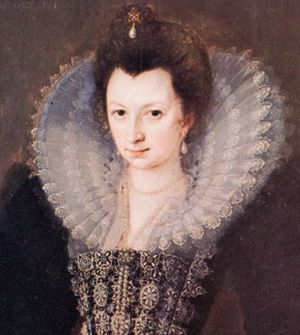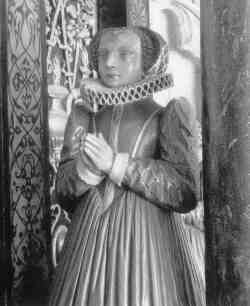Elizabeth Stanley, Countess of Derby facts for kids
Quick facts for kids
Elizabeth Stanley
|
|
|---|---|
| Countess of Derby Lord of Mann |
|

The Countess of Derby, by an unknown artist
|
|
| Born | 2 July 1575 Theobalds House, Hertfordshire |
| Died | 10 March 1627 (aged 51) Richmond, Surrey |
| Buried | Westminster Abbey |
| Noble family | De Vere (by birth) Stanley (by marriage) |
| Spouse(s) | |
| Issue | Lady Anne Stanley James Stanley, 7th Earl of Derby Sir Robert Stanley two daughters who died young |
| Father | Edward de Vere, 17th Earl of Oxford |
| Mother | Anne Cecil |
| Occupation | Maid of Honour Head of state and government administrator of the Isle of Man |
Elizabeth Stanley (born de Vere) was an important English noblewoman. She was known as the Countess of Derby and also held the special title of Lord of Mann. She was born on 2 July 1575 and passed away on 10 March 1627.
Elizabeth was the oldest daughter of Edward de Vere, 17th Earl of Oxford, who was a courtier and poet during the time of Queen Elizabeth I.
From 1612 to 1627, Elizabeth was the Lord of Mann. This meant she was the ruler of the Isle of Man. Even before she officially got the title, she was already helping to manage many things on the island. Elizabeth was the first woman to ever rule the Isle of Man as its head of state.
Before she got married, she worked as a Maid of Honour for Queen Elizabeth I of England. This was a special job helping the Queen. Her wedding, or possibly another wedding around the same time, might have been where William Shakespeare's famous play A Midsummer Night's Dream was first performed!
Early Life and Family
Elizabeth Vere was born on 2 July 1575 at Theobalds House in Hertfordshire. She was the oldest surviving daughter of Edward de Vere, 17th Earl of Oxford. Her mother was Anne Cecil. Anne's father, William Cecil, 1st Baron Burghley, was a very important person. He was Queen Elizabeth I's main advisor and a top member of her Privy Council (a group of trusted advisors). Elizabeth was baptised on 10 July.
Elizabeth had two younger sisters named Bridget and Susan. She also had a brother, Lord Bulbecke, who sadly died when he was a baby in 1583. Another sister, Frances, died in 1587. She also had a half-brother named Edward Vere. He was born to her father and Anne Vavasour.
After her mother, Anne Cecil, died in 1588, Elizabeth and her sisters lived with their grandfather, Lord Burghley. They received an excellent education there. In 1591, Elizabeth's father married again to Elizabeth Trentham. They had a son, Henry, in 1593. He later became the 18th Earl of Oxford.
Lady Elizabeth later went to the royal court. She became one of Queen Elizabeth's Maids of Honour. Her grandfather, Lord Burghley, even gave her a gold angel coin to play cards with when she started her career at court. She kept this job until she got married.
A Countess at Court
Around 1590, Elizabeth's grandfather, Lord Burghley, tried to arrange a marriage for her. He wanted her to marry Henry Wriothesley, 3rd Earl of Southampton. However, Henry did not want to marry Elizabeth.
Lord Burghley soon found Elizabeth another husband. On 26 January 1595, she married William Stanley, 6th Earl of Derby. Their wedding took place at Greenwich Palace. Queen Elizabeth I was there to witness it! Some people believe that William Shakespeare wrote A Midsummer Night's Dream especially for their wedding. It might have been performed at their wedding party. However, another wedding, that of Sir Thomas Berkeley and Elizabeth Carey, is also thought to be the occasion for the play's first performance.
A writer named Henry Lok wrote a poem for Elizabeth in 1597. Her husband was known for writing plays in 1599. In 1601, Elizabeth wrote to her uncle Robert Cecil. She asked him to stop a ban on her husband's involvement in plays. The main home for Elizabeth and her husband was Knowsley Hall.

In 1604, Elizabeth returned to court. She became a Lady of the Drawing Chamber for Queen Anne of Denmark. She also helped her younger sister, Susan de Vere, join the queen's household. Elizabeth was the main mourner at Queen Anne's funeral in 1619.
The Earls of Derby were the traditional rulers of the Isle of Man. So, Elizabeth's husband became the Lord of Mann in 1609. Elizabeth then started to take on many duties related to the island's government. She tried to help the Isle of Man with its business. For example, in 1609, she wrote a letter to her uncle Robert Cecil about sending money from the island. In 1612, Elizabeth was officially named the first female Lord of Mann. She held this important title until she passed away in 1627. Her oldest son, James, took over the title after her.
Elizabeth died on 10 March 1627 in Richmond, Surrey. She was buried the next day in Westminster Abbey in London. Her tomb, which she shares with her mother, grandmother, and sisters, has a sculpted figure of her.
Children
Elizabeth de Vere had five children:
- Lady Anne Stanley (born around 1600 – died February 1657). She married Sir Henry Portman first, and then Robert Kerr, 1st Earl of Ancram. She had children with Robert.
- James Stanley, 7th Earl of Derby (born 31 January 1607 – died 15 October 1651). He married Charlotte de la Tremoille and they had children.
- Sir Robert Stanley (died 1632). He married Elizabeth Gorges and had children. His family line eventually ended.
- Elizabeth Stanley (died young)
- Elizabeth Stanley (died young)

